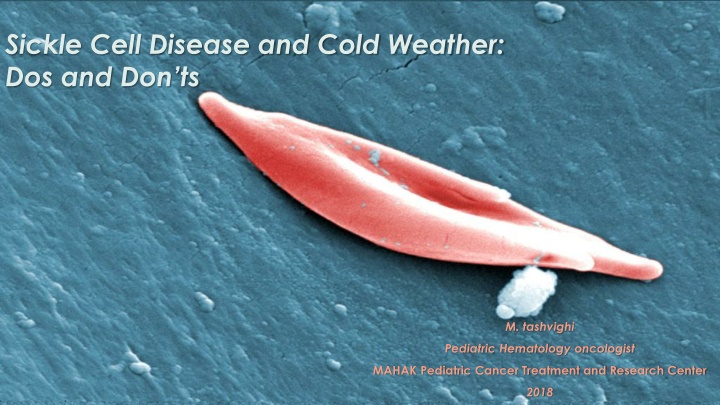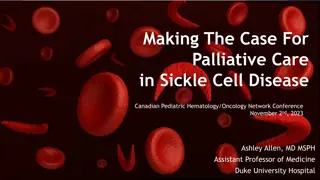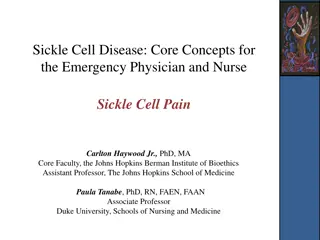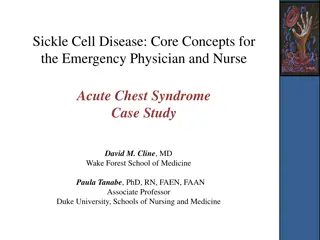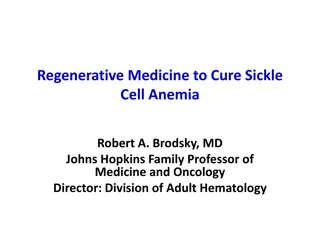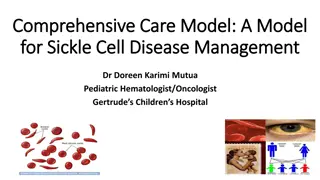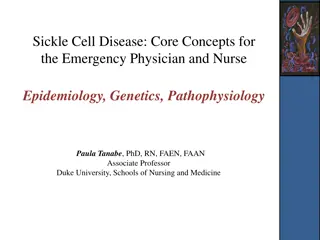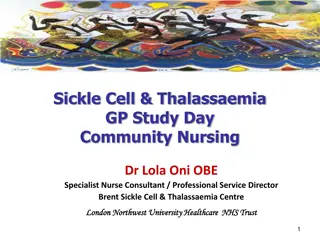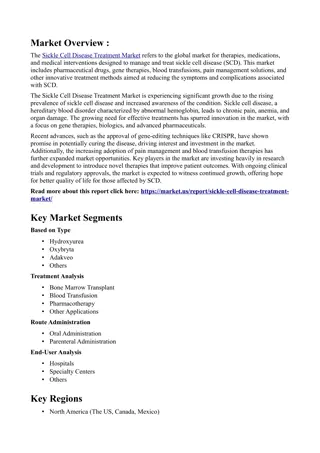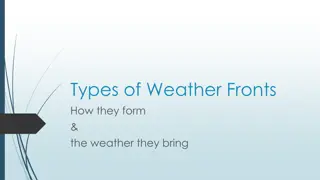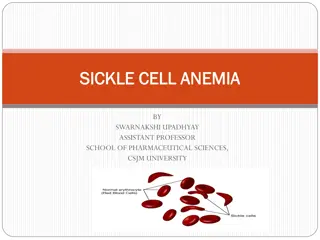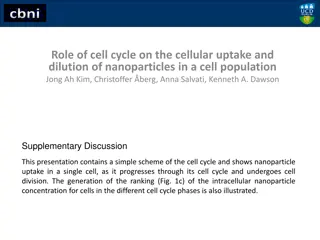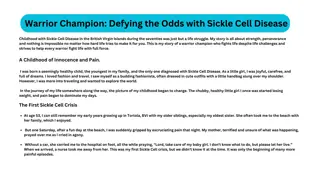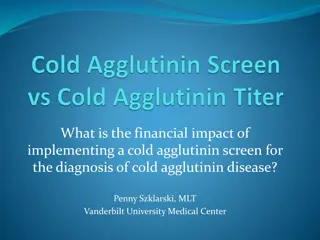The Impact of Cold Weather on Sickle Cell Disease
Patients with sickle cell disease (SCD) often experience painful episodes known as sickle cell crises due to abnormally shaped red blood cells. The severity of SCD can be influenced by genetic and environmental factors, with cold weather being linked to increased pain episodes. Research has shown correlations between cold temperatures and acute pain in SCD patients, with some studies suggesting changes in blood viscosity and oxygen levels as potential triggers. Understanding these relationships can help in managing and reducing pain in individuals with SCD.
Download Presentation

Please find below an Image/Link to download the presentation.
The content on the website is provided AS IS for your information and personal use only. It may not be sold, licensed, or shared on other websites without obtaining consent from the author.If you encounter any issues during the download, it is possible that the publisher has removed the file from their server.
You are allowed to download the files provided on this website for personal or commercial use, subject to the condition that they are used lawfully. All files are the property of their respective owners.
The content on the website is provided AS IS for your information and personal use only. It may not be sold, licensed, or shared on other websites without obtaining consent from the author.
E N D
Presentation Transcript
Sickle Cell Disease and Cold Weather: Dos and Don ts M. tashvighi Pediatric Hematology oncologist MAHAK Pediatric Cancer Treatment and Research Center 2018
Patients with sickle cell disease suffer from; Abnormally shaped Rigid Adhesive red blood cells These abnormal cells "close off" blood vessels and cause recurring, painful episodes called "sickle cell crises." Patients also describe SCD pain using neuropathic pain descriptors including aching , cold , hot , penetrating , shooting , stabbing , burning , tingling , numb , and lancinating
The clinical severity of (SCD) is dependent on genetic & environmental variables Environmental factors have been poorly studied
The link between acute pain and cold weather was first noted in a case report of a patient with SCD by George Graham in the USA in 1924, with the author speculating that cold may light-up a focus of infection and thus precipitate pain. In 1953, Edington reported that attacks of joint pain were linked to cold weather in ten of 33 patients in the Gold Coast (Ghana), and speculated that cold coincided with the rainy season and increased malarial infections, and that this was the main cause of increased pain.
Konotey-Ahulu, (Ghana), suggested that the peak incidence of pain occurred just before the cold rainy season, when the weather was still hot, and high levels of water vapor in the air causing a small, but critical, reduction in the partial pressure of oxygen.
New York (1970s) showed increased admissions to hospital with sickle pain in cold winter months even when episodes with overt infection were excluded, due to increased blood viscosity & cold diuresis. Other studies showing a link between acute pain and cold temperatures have been published from Kuwait, Virginia, USA and Canada.
A review of data from the Multicenter Study of Hydroxyurea from across the USA suggested that cold seasons were associated with increased pain severity but not frequency, and the same study also found more frequent and severe pain in hot months. France, a recent study showed that both high and low temperatures were associated with higher numbers of emergency attendances, although temperature drop was most significant on multivariate analysis; this study included acute pain and chest disease, in all forms of SCD.
The vast majority of patients with SCD live in tropical climates, in which few studies have been conducted. Increasing numbers are managed in temperate areas in western Europe, particularly in larger cities in France and the UK and North America many patients with SCD report that exposure to cold results in acute pain, usually starting within a few hours .
Do so in short intervals of 20 to 30 minutes with periods of rest and hydration in between. SCD can be extremely variable. SCD pain is reported to be provoked by increased wind speed and barometric pressure, colder temperatures, and touch.
Patients with SCD are hypersensitivity to thermal and mechanical stimuli compared to race-matched controls Older age was associated with lower cold, heat, and mechanical pain thresholds Painful events in SCD can be more severe & more frequently in cold weather Viral infections, flu-like illnesses and strep throat are more common in the winter, creating a perfect storm. Am J Hematol. 2013 Jan;88(1):37-43. doi: 10.1002/ajh.23341. Epub 2012 Oct 31.
Pathophysiology of cold exposure On cold exposure, peripheral vasoconstriction occurs in the skin, hands, feet, nose and ears &velocity of blood flowing through the vasculature of these areas is reduced vasoconstrictor reflex is even stronger in SCD patients Greater deoxygenation of blood in the peripheries, HbS polymerization , cause vaso-occlusion, presumably in tissues near to the areas exposed to cold. Cold sensitivity is greatly exaggerated in SCD,
Consequent to vaso-constrictive reduction in blood flow, a resulting decline in capillary pressure gradients produces lower shear force across the microvasculature. Another possibility is that vasoconstriction may be associated with diversion of blood (vascular steal) away from the active bone marrow and cause avascular necrosis and precipitate acute vaso-occlusion.
The balance between the different effects of cold exposure is complex, and likely to depend on a wide range of factors including ; Degree of vasoconstriction Hematocrit Range of temperatures Rapid temperature changes Housing, clothing other environmental factors(spent in heated & air-conditioned buildings)
Wind speed A study in London of 1,047 hospital admissions with acute pain of adults and children with SCD over 1,400 days found that high wind speeds (26 57 knots) were associated with significantly more admissions than low wind speed (4 16 knots) Effects of skin cooling seem the most likely to be relevant. Wind speed also correlates with; Temperature Humidity Some air pollutants This effect is exaggerated if the skin is wet Wind speed & painful episodes was found to be stronger among men, particularly those in the warmer climate regions of the United States
Humidity Studies examining the effects of humidity have produced mixed results. A study in Canada found higher pain scores in more humid months, Acute painful episodes were more common in humid weather in Kuwait. Higher humidity causing a lower partial pressure of oxygen. Low humidity (41 66%) was associated with increased admissions to hospital in London with acute pain when compared to high humidity (80 95%) French study found that both high and low humidity were associated with increased emergency admissions, with the fewest admissions occurring at around 70% relative humidity
Other climatic factors Rainfall does not influence acute complications in temperate European countries Although in countries with a tropical rainy season this is a cause of increased pain. There are no studies or case histories reporting the effects of snow on complications in SCD
A case reports of gangrene and amputation of limbs following the use of ice to treat pain in SCD, potentially serious effects of near freezing temperatures.
Air quality In 2005 it was estimated that pollution caused 800,000 premature deaths annually,and is 13th in the list of causes of mortality in the world. There is some evidence that this may alter gene expression through epigenetic mechanisms such as decreased DNA methylation Adults inhale about 20 m3 air per day, significant quantities of pollutant chemicals,may have implications for both acute and chronic complications of SCD.
Ozone Ozone in the troposphere is a secondary pollutant formed by reactions between primary pollutants released from fuel combustion and industrial processes, peak levels occurring on hot and sunny days strongly implicated in exacerbation of asthma, Asthma and wheezing are both strongly linked to increased acute complications in SCD more admissions with acute pain in SCD on days with higher ozone It has even been suggested that ozone might increase the rate and capacity of oxygen absorption in erythrocytes, making it a potential treatment for the prevention or shortening of acute complications in SCD.
Nitric oxide Nitric oxide has been strongly implicated in the pathophysiology of SCD Increased hemolysis results in functional nitric oxide deficiency, which contributes to vasculopathy& might be particularly important in the development of some complications including pulmonary hypertension, priapism, leg ulcers, and possibly cerebrovascular Exposure to atmospheric nitric oxide might be of therapeutic benefit in SCD,
Carbon monoxide As for nitric oxide, exposure to low levels of carbon monoxide is potentially therapeutic in SCD, with cytoprotective , vasodilator & anti-inflammatory properties, and platelet aggregation CO binds to hemoglobin with an affinity over 200 times that of O2 to form carboxy haemoglobin (HbCO), which increases the affinity of other binding sites for O2 left shift of the hemoglobin-oxygen dissociation curve. This reduces the level of deoxy HbS and the tendency for HbS to polymerise Medicine- Volume 93, Number 29, Decem
Inhaled CO reduces inflammation, leuco-cytosis, and vasoocclusion Early observations suggested that carbon monoxide prolonged the half-life of red blood cells in SCD. Higher levels of atmospheric carbon monoxide were also associated with lower numbers of admissions to hospital with acute pain due to SCD in London
Do: Dress warmly but in layers and carry an extra pair of dry socks. Stay hydrated (hot cocoa or herbal teas can be great). Carry and use a hand sanitizer frequently. Consider shopping online. Minimize continuous exposure to cold and windy weather or wet snow. Get plenty of rest and sleep, minimize stress, know your body and your limits. Make sure you have pain medications handy to start early in the event of a pain crisis.
Silk long johns/undershirts are good for keeping body heat close in your body. 100% cashmere is expensive, but lightweight and warm Cover your head, since 75% of body heat is lost through the head. Wear gloves wear warm clothes outside in cold weather and inside of air-conditioned rooms, and not to swim in cold water.
Don't: Forget your hat, gloves and scarf when you step out. Visit with people who have a cold or febrile illness, if possible. Drink too much coffee or caffeinated tea, since it can contribute to dehydration. Get carried away with the ice skating, sledding or building a snowman. A case reports of gangrene and amputation of limbs following the use of ice to treat pain in SCD, potentially serious effects of near freezing temperatures. By Deepa Manwani , Contributor |Jan. 5, 2016,
CONCLUSION There are significant association between increased numbers of admissions and low levels of nitric oxide , low levels of carbon monoxide & high levels of ozone O(3) There are significant correlations of VOC with weather conditions where colder temperatures and higher wind speed were associated with a higher incidence of VOC in children & adult Pain Manag Nurs. 2003 Sep;4(3):106-11 Br J Haematol. 2005 Nov;131(4):530-3.
